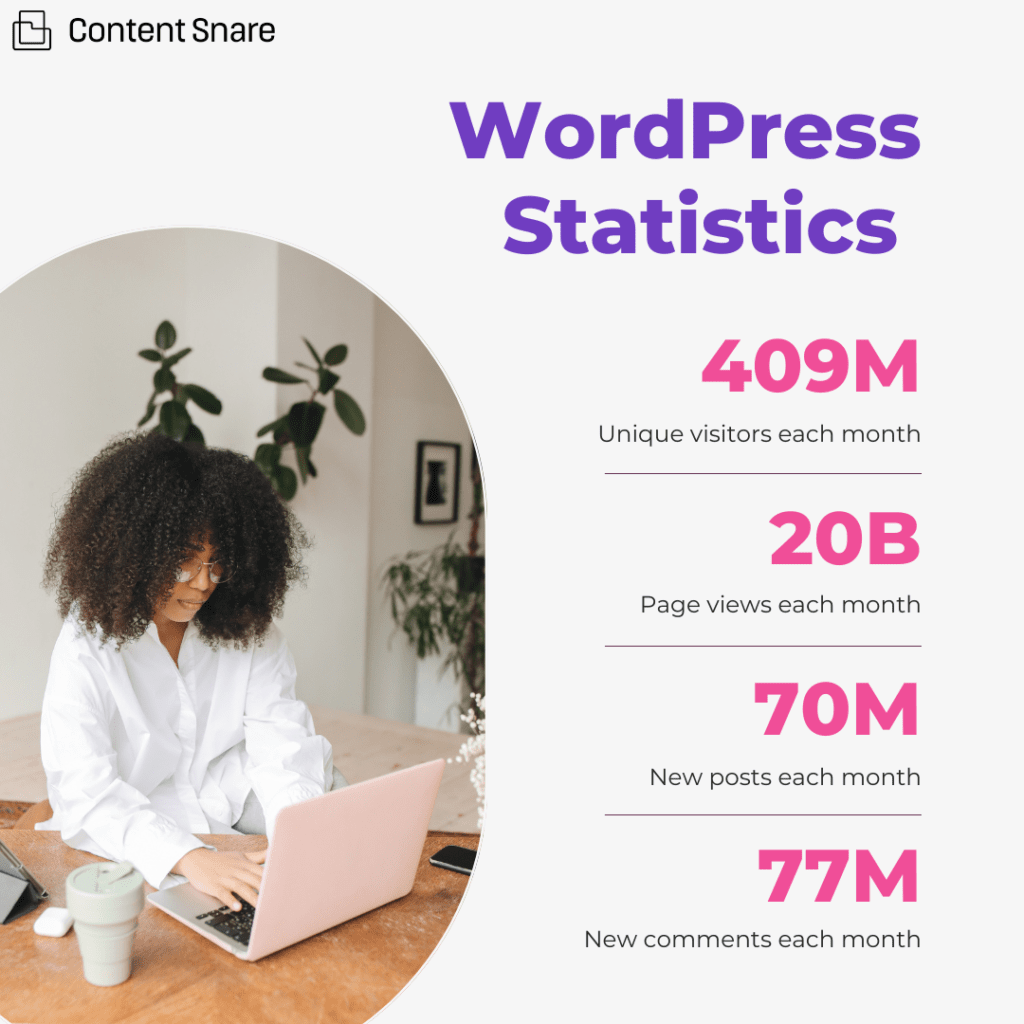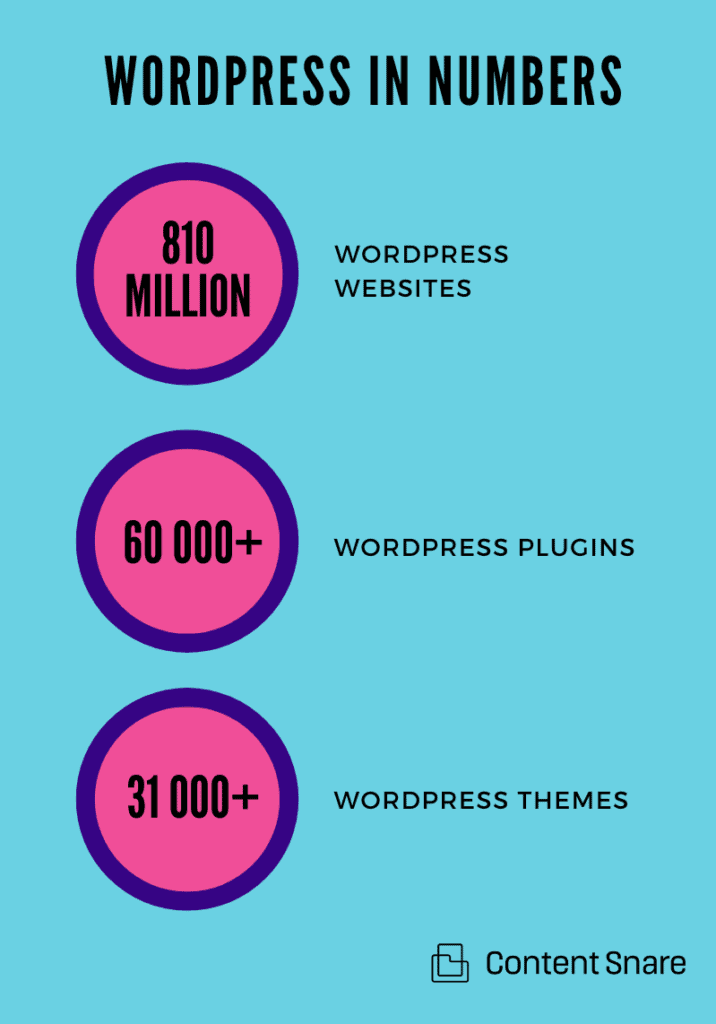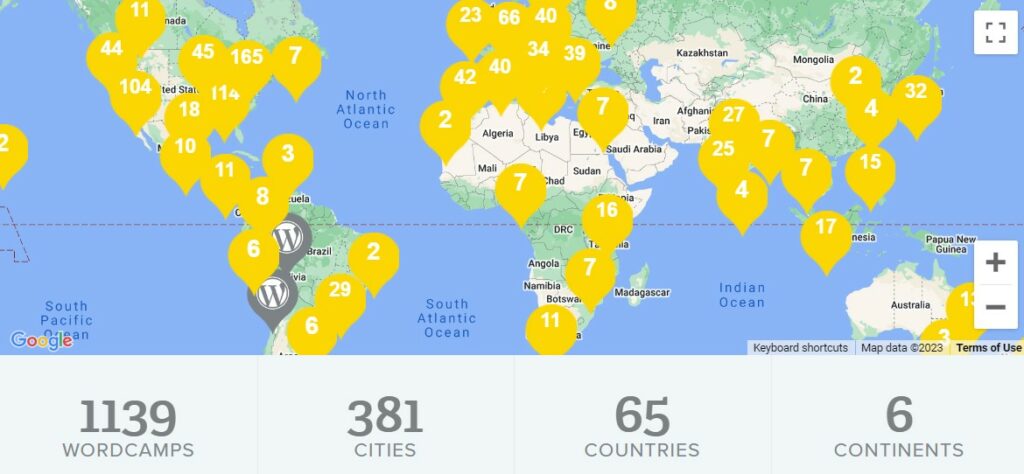You may see WordPress as a state-of-the-art content management system (CMS)—and rightfully so. But here’s an interesting fact: It’s been around for 20 years already.
Our old friend WordPress is the world's most commonly used CMS, powering millions of websites worldwide. Its user-friendly interface and customizable features have made it a go-to choice for bloggers, businesses, and developers alike.
But just how popular is it, really? And how many WordPress websites are there?
We’ve compiled the latest WordPress statistics for you to get a better understanding of the platform's reach and impact. It has come a long way since launching in 2003, so let’s see where it stands two decades later.
General statistics
WordPress has been the world’s most widespread CMS for ten years, but its dominance has never been as obvious as today. General stats reveal how many sites use WordPress and other important facts about this platform.
1. WordPress currently powers over 810 million sites (Colorlib)
However, most usage reports show that only around 20% of all 1.7 billion websites are really active. That goes for WordPress-powered sites and all others.
2. More than 43% of all websites use WordPress (W3Techs)
WordPress is the absolute market leader. The next big three platforms (Shopify, Squarespace, and Joomla) together power 11% of all websites.
3. 30% of the world’s top million websites use WordPress (BuiltWith)
The same goes for the top 10 thousand and top 100 thousand websites—WordPress powers nearly a third of those as well.
4. WordPress powers 30% of the Fortune 100 (Finances Online)
In addition to Fortune 100 companies, WordPress hosts elite websites like the New York Post, Vogue, Sony Music, Time Magazine, and many more.
5. Every day, 500 new websites are built with WordPress (Kinsta)
For context, all other CMS platforms combined help create up to 80 sites daily.

6. On average, WordPress usage has been increasing by 12% annually since 2011 (Creative Minds)
WordPress is the absolute leader in the number of websites hosted. However, it also powers the majority of high-traffic sites (with Shopify being a close second).
7. 19.9% of WordPress sites use the WooCommerce subcategory (W3Techs)
Elementor takes second place with 18.5%, while WPBakery is the third option with 13.4%.
8. WordPress-powered sites publish 27 new posts each second (AppMySite)
That translates to more than 2.3 million new posts per day or 16.5 million per week.
9. The most popular version of WordPress is 6.1 with nearly 80 million downloads (WordPress Counter)
More than 64% of all WordPress websites use the sixth version of the platform. The previous version still supports some 29% of sites.
10. Nearly half of Technorati’s top 100 blogs are managed with WordPress (Web FX)
That includes the New York Times, eBay, CNN, and Mashable.
WordPress plugins and themes statistics
WordPress sites wouldn’t be as functional without plugins and themes. The platform offers a massive library of tools that helps users customize and enhance the functionality of their websites. But how many WordPress plugins are there? And how about WordPress themes? Here are the key stats about these tools:
11. You can find more than 60 thousand plugins in the official WordPress plugin directory (WordPress)
WordPress plugins help websites with everything from SEO and analytics to popups and security. You can narrow down the options with keyword research.
12. With over five million active installations, Contact Form 7 and Yoast SEO are the most popular WordPress plugins (WordPress)
Many other plugins also have millions of active users. These include Aksimet, WP Forms, Jetpack, and so on.
13. Only 2% of all plugins have more than 10 thousand active installations (Colorlib)
In addition, only a third of WordPress plugins have more than 100 installations.
14. 3% of plugins have never been updated (Kinsta)
At the same time, 57% of plugins have never been rated by WordPress users.
15. The average price of a premium WordPress plugin is $138 (Creative Minds)
But that’s just the average price. Bear in mind that premium WordPress plugins can cost anywhere between $10 and $200+.

16. There are over 10 thousand free themes in the WordPress theme directory (WordPress)
Different themes enable different levels of customization. Some offer generic templates only, while the better ones are multipurpose and enable customized designs.
17. With premium options, the total number of WordPress themes goes up to 31 thousand (HubSpot)
You can find premium WordPress themes on websites like Theme Forest, Elegant Themes, StudioPress, and ThemeGrill.
18. The best-selling themes are clustered around the golden $59 price point (CodeinWP)
Most companies value themes similarly, which is why the average price of a WordPress theme is $57.5.
19. Divi, Astra, and Ultra are the most popular WordPress themes (Monster Insights)
Notable mentions include OceanWP, Guten Theme, Hongo, Elegant, and Avada.
20. Published in 2005, Kubrick was the first ever ‘official’ WordPress theme (Colorlib)
There was another one called “Classic” before 2005, but it wasn’t a genuine theme from today’s perspective.
WordPress security statistics
WordPress websites undergo serious security threats. The latest data shows the frequency of breaches, including the most common types of attacks. These stats are critical for WordPress users and developers who want to safeguard websites from potential threats.
21. At least 13 thousand WordPress websites are hacked every day (Better Studio)
In other words, 4.7 million WordPress websites are hacked on a yearly basis.
22. WordPress faces 90 thousand malicious attacks every minute (How to WP)
That means there are almost 130 million malicious attacks targeting WordPress sites every day.
23. WordPress sites receive 487 billion spam messages a month (WP Data Tables)
The number of spam messages is 6,208 times higher than the number of real comments.
24. Plugins account for 90% of all WordPress vulnerabilities while theme and core vulnerabilities make up 10% (HubSpot)
That’s mostly because admins don’t switch to the latest version of WordPress, plugins, or themes. The risk of getting hacked is drastically lower if you automatically update all tools.
25. WP Scan currently recognizes nearly 40 thousand WordPress vulnerabilities (WP Scan)
97% of vulnerabilities are detected in free themes and plugins.

26. 90% of Sucuri’s cleanup activity involves WordPress websites (Sucuri)
Magento, Joomla, and all other CMS platforms make up 10% combined.
27. 81% of WordPress websites get hacked because of a weak or stolen password (Panda Security)
You should never use passwords like “qwerty” or “123456”. It’s best to create a strong password containing both uppercase and lowercase letters, numbers, and special characters.
28. 61% of all infected websites feature an out-of-date WordPress version (Startup Vortex)
Two-thirds of websites still rely on older WordPress versions, and they often fail to install updates.
29. Nearly 50% of website administrators didn’t enable auto-updates for WordPress, its plugins, and themes (WP White Security)
Still, 96% of website administrators claim that WordPress security is very important.
30. It costs up to $4,800 to clean up a hacked website (Better Studio)
Analysts expect global cybercrime costs to grow by 15% annually until 2025. Investing in cybersecurity is more important than ever.
Random WordPress statistics and facts
The WordPress ecosystem is huge and colorful. It involves millions of individuals and organizations from all over the world. Here are some random WordPress facts and stats to enjoy.
31. The average annual salary for a WordPress developer is $70 thousand (Glassdoor)
The salary can go up to $114 thousand per year depending on the developers’ skills and experience. However, junior WordPress developers may receive only $44 thousand a year.
32. Open Hub estimated that it would take 240 person-years to build WordPress (Open Hub)
In other words, 240 developers would take a whole year to write the entire WordPress code. At the moment, the code contains some 884 thousand lines.
33. Automattic, the company behind WordPress, is worth $1.8 billion (Growjo)
The CEO of Automattic is Matt Mullenweg, one of the initial developers of WordPress. Automattic generates $780 million in revenue per year.
34. The company has around 3,800 employees (Owler)
Automattic is located in San Francisco, but most of its employees work from home.
35. To date, there have been over 1,100 WordCamps (WordPress-focused conferences) in 65 countries (WordCamp Central)
WordCamps are informal and locally-organized conferences where participants discuss everything related to WordPress.

36. WordPress releases a major update to its core software 2 to 3 times per year (Colorlib)
You can expect a major update every three to six months. However, lots of minor updates take place weekly or even daily.
37. More than 70% of WordPress content is written in English, while Spanish takes second place with 4.7% (Digital)
Indonesian is third on the list with 2.4% of the content.
38. The platform is available in 208 languages (WordPress)
WordPress hosts a special blog dedicated to the translators of this open-source project. You are free to join the platform if you want to help translate WordPress to your language.
39. “WordPress” as a word gets nearly three million searches per month (Li Creative Technologies)
And that’s just the core keyword. If we add long-tail keywords to the equation, WordPress gets 37 million monthly searches.
40. Mobile users generate 59% of traffic on WordPress sites (Manaferra)
The last entry on our list proves the general trend in device usage. Three out of five WordPress interactions take place through smartphones, while computers and tablets make up the rest.
WordPress statistics: The numbers don’t lie
WordPress continues to dominate the CMS market, and its usage stats show no signs of slowing down. From blogging to eCommerce, WordPress attracts all sorts of user profiles. But as the platform continues to grow and evolve, it will be interesting to see how these stats change in the years to come.



